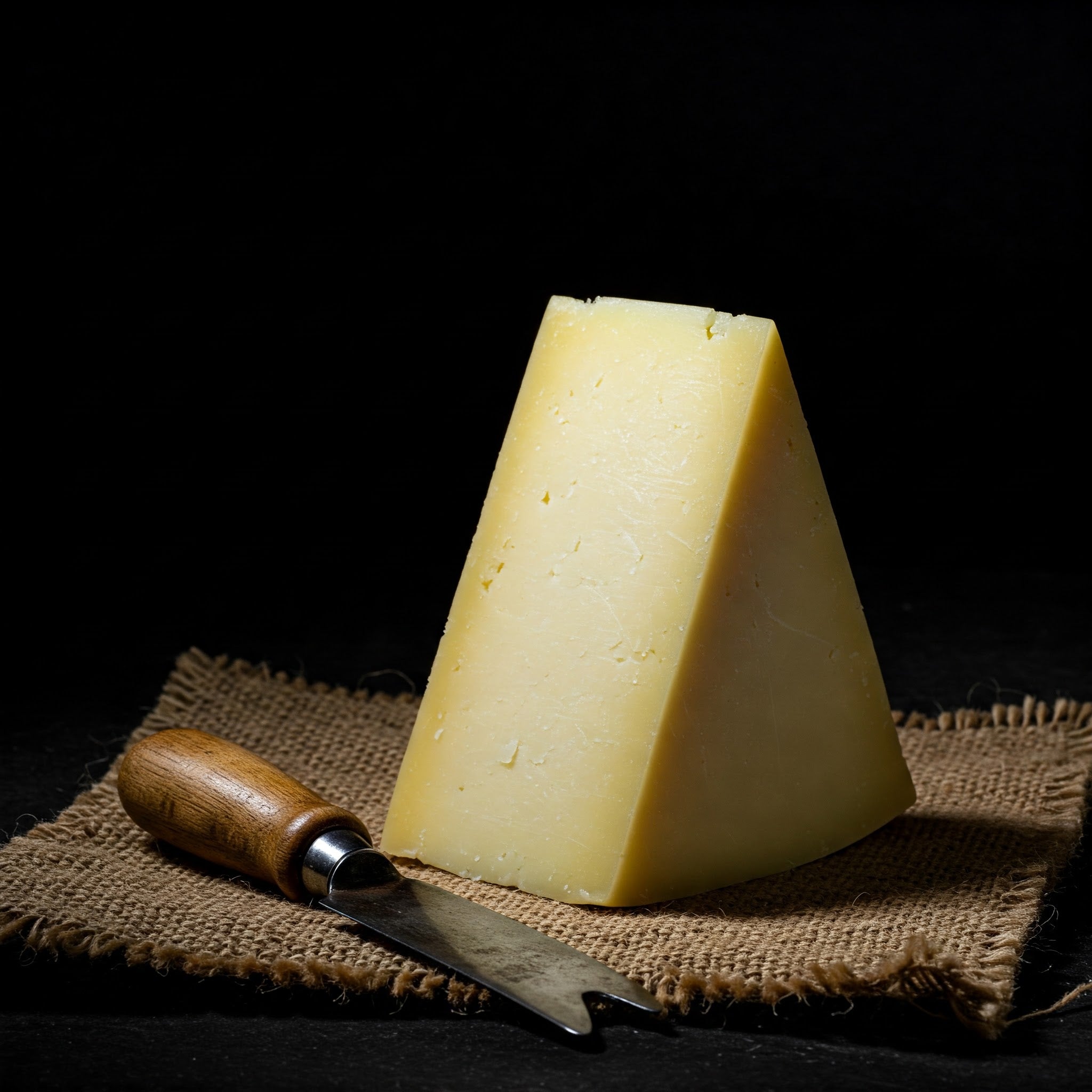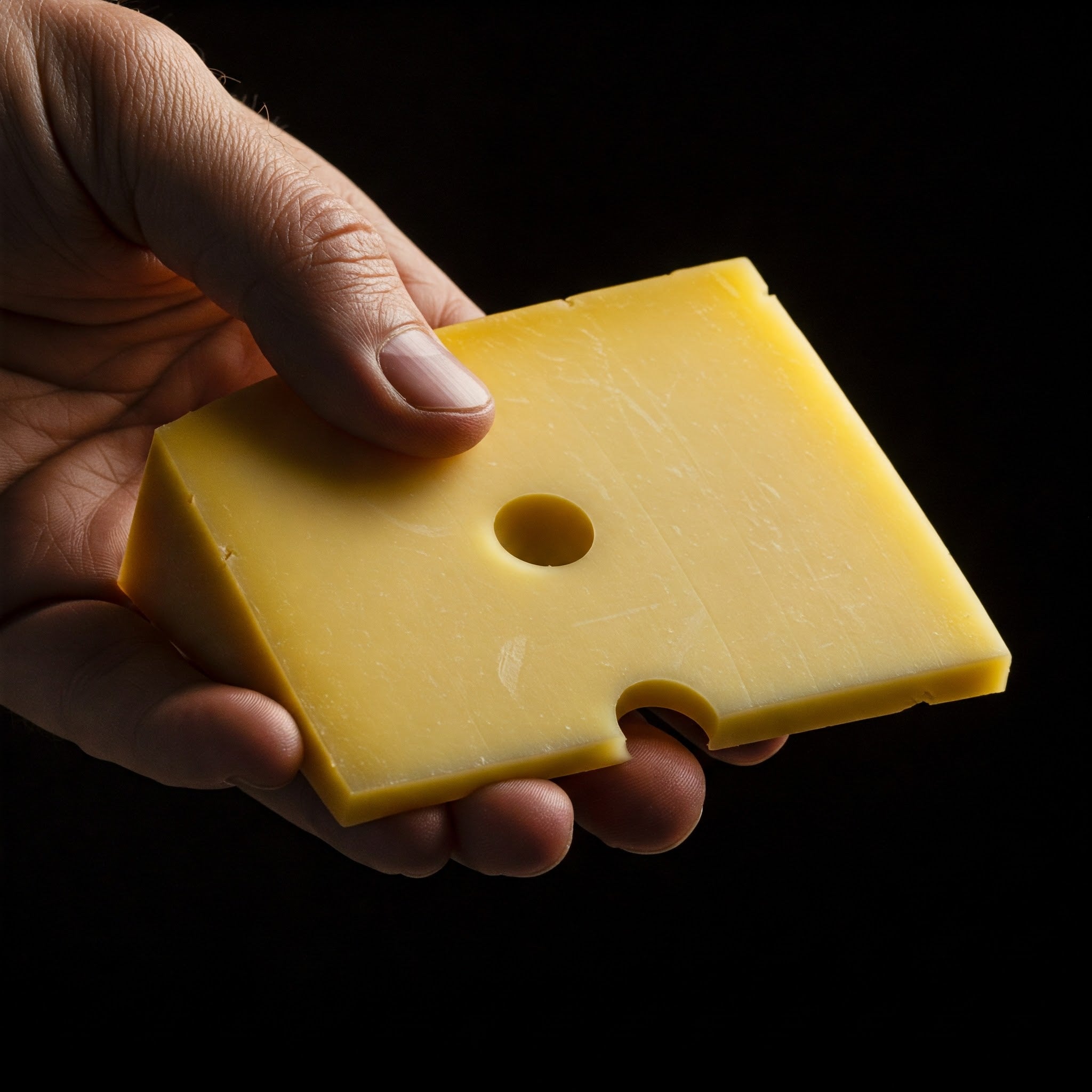What kind of cheese will I get?
The Wedgely Difference: Years of Cheese Expertise

As Featured In




Hundreds of cheese lovers rely on Wedgely for bold flavors and expert curation

Got Questions? We’ve Got You Covered!
The Latest From Wedgely's Blog
Why Cheese Melts (and Why It Matters)
If you’ve ever made a grilled cheese only to watch your cheddar turn oily instead of gooey, you’ve run into the mysterious science of cheese melting. Some cheeses transform into a velvety blanket, while others stay stiff—or worse, separate into pools of fat.
Understanding why cheese melts comes down to three main factors: fat, moisture, and acidity. Once you know how they work, you’ll be able to choose the best melting cheeses for every occasion, from bubbling fondue to a pizza that pulls perfectly stretchy slices.
The Role of Fat in Cheese Melting
Cheese is made up of proteins, water, and fat. When you heat cheese, the fat softens and disperses, giving melted cheese its creamy texture. But too much fat can cause separation—think of aged cheddar that turns greasy.
- High-fat cheeses like brie or triple-cream cheeses become luxuriously soft but may not hold structure.
- Lower-fat cheeses can resist melting and instead become rubbery.
Wedgely tip: For gooey results, aim for cheeses with a balanced fat content, like young gouda or fontina.
How Moisture Content Affects Meltability
Moisture is the magic that helps cheese turn silky instead of stiff. Younger cheeses with higher moisture (like mozzarella) melt beautifully, stretching into long strands. Aged cheeses lose water over time, concentrating proteins that resist flow, which is why Parmesan doesn’t melt smoothly but instead crisps up.
- High-moisture = stretchy melt (mozzarella, Monterey Jack).
- Low-moisture = limited melt (Parmesan, pecorino).
💡 Wedgely tip: Blend cheeses to balance moisture. A mix of mozzarella and provolone makes the perfect pizza topping.

The Influence of Acidity and pH
Cheese acidity (measured by pH) determines how tightly proteins are bound together.
- Ideal pH for melting: Around 5.3 to 5.5. Cheeses in this range, like Havarti or Colby, melt smoothly.
- Too acidic (low pH): Cheeses like feta or paneer hold their shape and don’t melt.
- Too alkaline (high pH): Cheeses may brown before they flow.
Wedgely tip: For a foolproof melt, pick cheeses in the sweet-spot pH range—like Gruyère, the gold standard for fondue.
Best Melting Cheeses for Every Occasion
Now that you know the science, let’s put it into practice. Here are Wedgely’s favorite picks for the ultimate melty moments:
Fondue Night
- Gruyère
- Emmental
- Fontina
Pizza Perfection
- Fresh mozzarella
- Provolone
- Young gouda
Grilled Cheese Bliss
- Havarti
- Colby
- Mild cheddar (paired with a slice of mozzarella for stretch)
Wedgely pairing idea: Add a side of fig jam or pickled onions from your Wedgely box for the ultimate gourmet twist.
Why Some Cheeses Don’t Melt at All
Ever noticed that paneer, halloumi, or feta stay solid in the pan? That’s because their protein structures are set during production, and their acidity is too low for proteins to loosen when heated. Instead of melting, they keep their shape—perfect for grilling but not for that gooey pull.
Bringing It All Together
Cheese melting isn’t random—it’s all about fat, moisture, and acidity working in harmony. With a little cheese science, you can choose the right wedge for every recipe.
At Wedgely, we curate boxes with a mix of melt-friendly favorites and unique discoveries, so whether you’re craving pizza night, fondue indulgence, or a gourmet grilled cheese, you’ll always have the perfect bite on hand.
Few dishes evoke comfort quite like a warm, gooey bowl of macaroni and cheese. It's a classic for a reason, but achieving that truly perfecting macaroni and cheese experience—creamy, rich, and deeply flavorful—is an art form. At Wedgely, we believe every cheese lover deserves to master this beloved dish. Forget the boxed versions; we're here to guide you through crafting an unforgettable homemade mac and cheese that will earn rave reviews.

The Secret to Perfect Mac and Cheese
Achieving the ultimate creamy texture and rich flavor in your perfect mac and cheese starts with understanding a few key principles. It's about balance, quality ingredients, and a little bit of love.
1. The Cheese Selection: It's All About the Blend The foundation of any great macaroni and cheese is, naturally, the cheese! Don't settle for just one. A blend creates depth and complexity. Aim for a mix of good melting cheeses and those that bring robust flavor.
Sharp Cheddar: Your backbone! Provides that essential tang and classic "cheese" flavor. We recommend a high-quality aged cheddar for more punch.
Gruyère or Comté: For nutty, earthy notes and superior melting. These Alpine cheeses add sophistication.
Fontina or Monterey Jack: Excellent melters that contribute to a silky smooth texture.
A Touch of Parmesan or Pecorino Romano: For a salty, umami kick. Use sparingly for flavor, not melt.
Wedgely Tip: Always shred your own cheese! Pre-shredded varieties often contain anti-caking agents that can make your sauce gritty. For the best cheeses for mac and cheese, explore our curated selection.
2. The Creamy Sauce: A Velvety Foundation The roux-based béchamel is the heart of your creamy cheese sauce.
Start with a Roux: Melt butter, then whisk in an equal amount of flour. Cook for 1-2 minutes until golden, creating a nutty base.
Slowly Add Milk: Gradually whisk in warm milk (whole milk for richness!). Do this slowly to avoid lumps, ensuring a smooth sauce. Cook until thickened.
Season Generously: Salt, freshly ground black pepper, a pinch of nutmeg (a secret weapon for cheese sauces!), and a dash of cayenne pepper or Dijon mustard for a subtle kick.
Melt Your Cheese: Remove the sauce from the heat, then gradually stir in your shredded cheeses until fully melted and smooth. This prevents the cheese from becoming oily or stringy. This creamy cheese sauce is crucial for your perfect macaroni and cheese.
3. Pasta Perfection: The Unsung Hero While the cheese gets the glory, the pasta is equally important.
Choose the Right Shape: Elbow macaroni is traditional, but shells, cavatappi, or even orecchiette work wonderfully. Look for shapes with nooks and crannies to trap that delicious sauce.
Cook Al Dente: Boil your pasta according to package directions, but remove it about 1-2 minutes before it's fully cooked. It will finish cooking in the cheese sauce and in the oven, preventing mushiness. This ensures the best macaroni and cheese pasta.
4. Baking for Bliss: The Golden Finish While stovetop mac and cheese is great, a baked version offers an irresistible golden crust.
Combine and Transfer: Mix your cooked pasta with the cheese sauce thoroughly. Pour into a greased baking dish.
Topping Time: For extra crunch, sprinkle breadcrumbs (panko works great!), more shredded cheese, or even a mix of crushed crackers on top.
Bake to Golden Perfection: Bake at 350°F (175°C) for 20-30 minutes, or until bubbling and the topping is golden brown. Let it rest for a few minutes before serving to allow the sauce to set slightly. This baked mac and cheese technique guarantees a delightful texture.
Your Ultimate Comfort Food Awaits
Crafting the perfect macaroni and cheese is a rewarding culinary journey. By focusing on quality cheeses, a velvety sauce, perfectly cooked pasta, and a delightful finish, you'll create a dish that's truly a masterpiece. We encourage you to experiment with different cheese blends from Wedgely's selection to find your personal favorite recipe.
Get ready to impress!
Buying great cheese should never feel intimidating. In fact, it should be one of life’s small but joyful adventures—a delicious quest for your next favorite flavor. Whether you’re standing in front of a packed cheese case at your local shop or exploring our curated selection online.
Here’s how to choose and buy cheese with confidence and curiosity.

1. Befriend Your Cheesemonger (or Your Wedgely Curator!)
If you’re at a specialty shop or market, your cheesemonger is your secret weapon. Ask questions! Ask for tastes! Tell them what you’re planning—whether it’s a solo snack, a romantic date night, or a festive dinner party—and let them guide you. The best cheesemongers are flavor matchmakers, and they love connecting people with cheeses they’ll adore.
And here at Wedgely, we like to think of ourselves as your personal cheese curators. Our selections are carefully chosen to take you on a journey of taste, and our detailed tasting notes and pairing suggestions are designed to help you discover new favorites.
2. Buy for the Moment, Savor the Now
Cheese is a living thing, and many varieties are best enjoyed fresh or within a week or two of purchase. Don’t buy in bulk unless you're prepping for a party or know you’ll devour it quickly (we get it!). Instead, focus on selecting the perfect amount for your immediate enjoyment and let your next cheese experience be just around the corner.
- Fresh cheese? Enjoy it within a few days to experience its delicate flavors at their peak.
- Aged wedge? You’ve got a bit more time to savor its complex notes, but don’t let it languish in your fridge.
3. Don’t Judge a Cheese by Its Rind (Embrace the Unexpected)
That rustic gray coating? Totally normal! That orange, gooey edge? Probably intentional, and delicious! Rinds vary wildly in texture, color, and aroma—and they’re often edible (but not always delicious).
When exploring cheeses in person, ask your cheesemonger which rinds are meant to be enjoyed and which are best trimmed away. And when you shop with Wedgely, we’ll always provide you with the information you need to make the most of every bite.
4. Trust Your Senses: A Flavor Adventure
Let your senses guide you. If you’re shopping in person, take a moment to smell the cheese. Observe its texture. Is it oozy and decadent? Crumbly and rustic? Silky and smooth? Don’t be afraid to ask for a sample if that’s an option.
And when you're browsing our Wedgely selections, immerse yourself in our detailed tasting notes and customer reviews. Look for the flavor profiles that speak to you—whether you're drawn to buttery richness, nutty complexity, earthy depths, or tangy brightness.
5. Explore the World of Milk
Cow, goat, sheep, buffalo—each milk type brings its own unique character to the cheese:
- Cow’s milk: Classic and approachable, offering a wide range of flavors and textures.
- Goat’s milk: Tangy, bright, and sometimes with a subtle citrusy zing.
- Sheep’s milk: Rich, nutty, and buttery, often with a luxurious mouthfeel.
- Buffalo’s milk: Creamy and intense, the foundation of true mozzarella di bufala.
We encourage you to explore the diversity of milk types in our Wedgely boxes and discover your personal preferences.
6. Read the Label: Your Cheese Passport
A cheese label is your passport to understanding its origins and characteristics. Look for:
- The milk type: Your guide to flavor and texture.
- Country of origin: A hint at the cheese's heritage and terroir.
- Pasteurized or raw: Information about the milk's treatment.
- Style or texture: Clues about what to expect on your palate.
- Age (young, aged, etc.): An indication of flavor intensity and complexity.
But remember: Even within these categories, flavor can vary dramatically. A mild Brie and a funky Brie can both be incredibly delicious—just in different ways.
7. Embrace the Seasons: Cheese in Its Prime
Yes, cheese has a season! Fresh, bright chèvre shines in spring, while rich, complex Alpine styles reach their peak in fall. Shopping seasonally means you’re experiencing cheese at its most flavorful—and often supporting smaller producers who work in harmony with nature's rhythms. We at Wedgely strive to bring you the best of each season.

Wedgely's Philosophy: Shop With Your Eyes, Your Heart, and Your Taste Buds
At Wedgely, we believe that the most rewarding cheese experiences come when you follow your instincts and embrace your cravings. Don’t be afraid to step outside your comfort zone. Never tried a washed rind? Go for it! Always skip the blues? Give one a chance—you might be surprised.
Every cheese tells a story: of the land, the animals, the cheesemaker's art, and the passage of time. Let your next wedge, whether from a local shop or a Wedgely's curated cheese box delivery, be a delicious new chapter in your own culinary story.
Hey there, fellow cheese enthusiasts! If you're anything like us, your love for artisanal cheese runs deep. It's more than just a food; it's an experience, a journey of flavor, and often, the centerpiece of unforgettable moments shared with loved ones. Welcome to Wedgely, where we make finding your next perfect cheese an absolute delight.
Our passion for gourmet cheese has always been about connecting people with exceptional culinary experiences. For me, enjoying a cheese board is an art form, a sensory exploration, and a chance to slow down and truly savor.
The Art of the Perfect Cheese Board
Imagine this: a beautifully arranged cheese board isn't just an assortment of premium dairy and gourmet crackers. It’s an invitation to explore new cheese flavors, to discover expert cheese pairings, and to create wonderful memories. Over the years, I've seen how a perfectly curated cheese selection can elevate any occasion. From the sharp tang of an aged cheddar to the creamy indulgence of a triple-crème brie, each cheese wheel or cheese wedge tells a story of craftsmanship, terroir, and tradition.
This is exactly where Wedgely excels. We've dedicated ourselves to bottling that very essence of cheese discovery and delight. Our mission is to seamlessly deliver an unparalleled cheese experience right to your door.
Why Wedgely is Your Go-To Online Cheese Shop
At Wedgely, we don't just sell cheese online; we provide a complete cheese delivery service that brings the world's best directly to you.
– Curated Cheese Selection: We don't just stock everything; our experts hand-pick every gourmet cheese. This careful cheese curation saves you time and guarantees high-quality cheese, ensuring every wedge is a winner for your cheese tasting adventure.
– Farm-Fresh Quality & Delivery: We prioritize ensuring that what arrives at your door is peak-quality cheese. Wedgely consistently delivers on this promise, from fresh mozzarella to aged parmesan, fundamental to providing the best online cheese experience.
– Easy Cheese Discovery: The vast world of fine cheese can be intimidating. Wedgely makes cheese exploration accessible and exciting, fostering repeat engagement because there's always something new to buy cheese online. Discover unique cheese varieties and expand your cheese palate.
– Community for Cheese Lovers: A great brand builds a community. Wedgely's focus on sharing the love of delicious cheese creates a natural connection with its audience, turning one-time buyers into loyal advocates for Wedgely cheese.
From sourcing award-winning cheeses to providing ideas for your next charcuterie board or picnic cheese spread, our dedication builds lasting relationships with our customers and the incredible cheeses we offer.
Your Next Cheese Adventure Awaits!
So, whether you're planning your next dinner party cheese board, a cozy at-home cheese experience, or simply looking for the perfect cheese gift, I encourage you to explore Wedgely's collections. Discover your next favorite artisanal cheese, experiment with new cheese pairings, and most importantly, savor every delicious cheese bite.
What's your go-to cheese from Wedgely, or what are you most excited to try next from our online cheese shop? Share your thoughts in the comments below!
Happy cheesing,
The Wedgely Team





